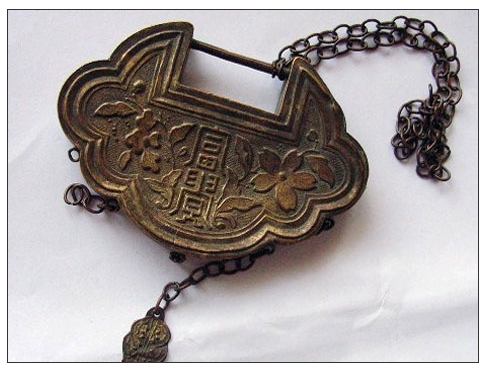
One of the more interesting forms of Chinese charms is the lock. This type of charm is based on the traditional Chinese device used to safeguard possessions and property. The charm, however, is flat and of one piece with no moving parts. The shape is similar to the Chinese character ao which means "concave".
It is always decorated with Chinese characters and symbols.
The purpose of the lock charm is similar to that of the other charm types in that it is meant to protect a person from evil and to bring good luck, fortune, official rank and long life.
These padlocks could be bought at silversmith shops and varied in size and shape. Sometimes Buddhist or Taoist (Taoist) priests tied them with their own hands around the necks of children.

This is the obverse side of an old Chinese lock charm. The smaller character at the upper right and the smaller character at the upper left are read as san xian which means the "Three Immortals". The Three Immortals are the most important of the so-called "household" or "kitchen" gods. While these gods are not usually worshipped, they are believed to bring good luck and small statues or pictures of them are found in almost every family home.
The three large Chinese characters in the middle of the charm are the actual names of the Three Immortals. Read right to left, they are fu lu shou which means "happiness, emolument (which was the salary a government official received), and longevity. Fu is the God of Happiness (God of Good Fortune and Blessings). Lu, the God of High Ranking Office (God of Rank and Emolument), is usually shown as holding a ruyi which was originally a short sword with a sword-guard used for self-defense or gesturing but now symbolizes good wishes ("may things go as you wish") and prosperity. Shou , the God of Longevity, is usually shown with a walking stick and carrying a peach which symbolizes long life.
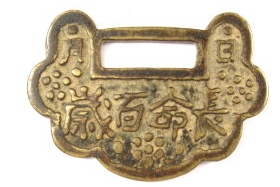
This is the reverse side of the lock charm. The large Chinese characters in the middle are read right to left as chang ming bai sui which can be translated as "long life of 100 years". The small character at the upper right is ri which means sun or day. The small character at the upper left is yue which means moon or month. Displaying the sun and moon in this way symbolizes that the charm's good luck should be continuous day and night. Above and below each of these Chinese characters, and on the bottom of the obverse side of the charm, are dots representing stars. The sun, moon and stars together are known as the "three lights" (sanguang ) and are considered a symbol of good luck.
To the right, left and below the inscription are clusters of five dots which represent the plum blossom. The plum blossom is also displayed at the very top right and top left on the obverse side of the charm. In winter, the plum blossom grows new flowers from seemingly dead branches. It, therefore, offers the promise of renewal and rejuvenation, continuity and happiness of life, in the face of adversity.
The plum blossom symbolizes the "five blessings" (wufu), also known as the "five happinesses" or "five good fortunes". These five blessings refer to longevity , wealth , health and composure , virtue , and the desire to die a natural death in old age . These blessings are consistent with the meanings of the inscriptions on both the obverse and reverse of the charm.
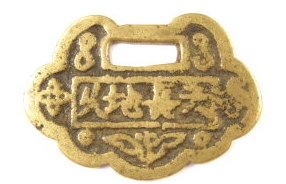
This old lock charm is smaller and has clearly seen a great deal of use over the centuries.
The inscription from right to left reads tian chang di jiu which can be translated as "as eternal and unchanging as the universe".
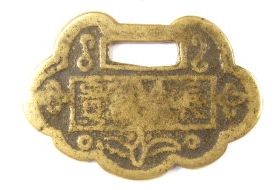
The inscription on the reverse side is so worn that the characters are barely legible. Read from right to left is the very common auspicious inscription chang ming fu gui which translates as "longevity, wealth and honor".
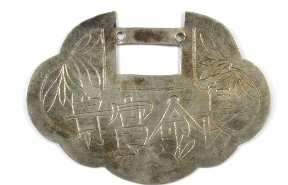
This is an example of a Chinese lock charm made of silver.
The inscription, the same as that of the lock charm above, is chang ming fu gui which means "longevity, wealth and honor".
There is a tree peony or mudan flower at the very bottom. This flower is also known as fuguihua which means "flower of wealth and honor".
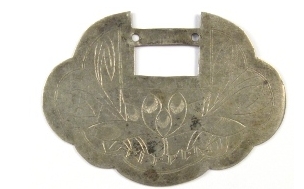
The reverse side of the lock charm displays a lotus.
In Chinese, the lotus is lianhua or hehua . Lian is also the pronunciation for "continuous" and he is the pronunciation for "harmony" . The lotus, therefore, has the hidden meaning of "continuous harmony".
In the center are displayed three lotus pods. Lotus seeds (lianzi) convey the auspicious meaning of "continuous birth of children" because lian sounds like "continuous" and zi has the same pronunciation as "son" or "child".





